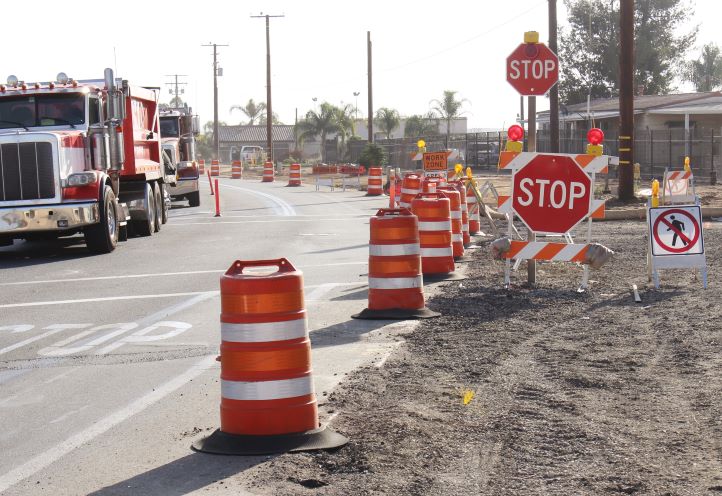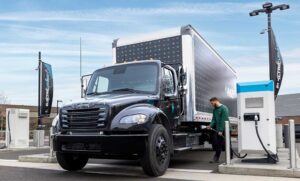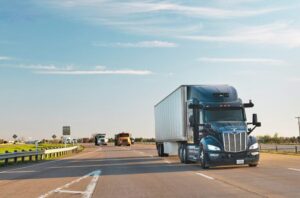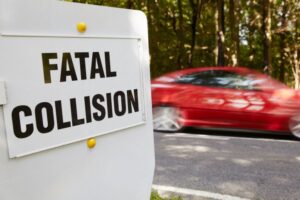NEW YORK — Results from a pilot program using in-cab technology to help operators of heavy trucks identify potential hazards in urban areas reveal a reduction in speeding and an increased awareness of vulnerable road users (VRUs) around the vehicle.
Together for Safer Roads (TSR) announced these findings from its Truck of the Future (ToF) program April 18. The program, conducted throughout 2023, utilized aftermarket technologies to help prevent potential conflicts between large fleet vehicles and VRUs.
“The findings from the Truck of the Future pilot program underscore the transformative potential of innovative technologies to make roads safer for vulnerable road users and fleet vehicle drivers alike,” said Peter Goldwasser, executive director of TSR. “TSR remains committed to fostering cross-sector collaborations that prioritize the safety of all road users in ways that are actionable and scalable.”
Recent data underscores the urgent need for measures to protect VRUs: In 2021, 84% of the 7,388 pedestrian fatalities recorded occurred in urban areas, according to the Insurance Institute for Highway Safety. The ToF pilot program, a public-private partnership, sought to address this challenge by installing VRU Detection Systems on fleet vehicles, providing drivers with enhanced visibility and real-time feedback on potential near misses.
The VRU technology, developed by TSR member VisionTrack, uses AI-powered cameras to detect pedestrians, bicyclists, motorcyclists and scooter users around the vehicle. Fleets participating in the pilot include The City of New York, with 10 vehicles each from two separate city departments, and AB InBev’s subsidiary in Mexico City, which had 10 vehicles participate in the pilot.
“Video telematics are a vital component of a comprehensive fleet safety plan, especially as it relates to after-market vehicle modifications,” said Matthew Ison, vice president of sales-North America at TSR member VisionTrack. “We are thrilled to be involved in the Truck of the Future pilot and showcase specifically the increasing capabilities of AI in telematics to provide drivers with greater awareness of surrounding VRUs, change driving behaviors, and create safer roads for all.”
A total of 67,732 VRU alerts were collectively recorded over the course of the pilot program amongst the three participating fleets. Only VRUs detected within 0.8 meters of the vehicle were flagged to the driver. This volume of close-proximity VRU alerts underscores the challenges faced by drivers on today’s roads, and the importance of a technology that provides drivers with a 360-degree view of vision around the vehicle and alerts of imminent risks.
“As a corporate participant with one of the larger global fleets, and as a founding member of Together for Safer Roads, we are encouraged by the positive outcomes of the Truck of the Future pilot program,” said Catalina Garcia Gomez, global director of corporate affairs at AB InBev. “This initiative aligns with our commitment to promoting responsible and safe driving practices among our drivers.”
Key findings from the pilot program study include:
- Reduction in speeding
Installation of the VRU Detection System was associated with a decrease in speeding over time, particularly in the most severe ‘red’ category and among outlier speeders. This finding was surprising as the system did not directly alert drivers when they were speeding. The reduction in speeding suggests the VRU Detection System’s benefits may go beyond providing indirect vision and detection alerts, to creating positive behavioral shifts among drivers towards safer practices. Speeding, as we know, is a leading contributing factor to both crashes and the severity of said crashes once they occur.
- Increased awareness of VRUs
Over time, drivers using the AI systems demonstrated greater awareness of VRUs. In one fleet, the proportion of VRU alerts that occurred while the driver was speeding decreased over time, suggesting that drivers consciously slowed down in areas where a VRU was likely to be detected. Meanwhile, a NYC department saw more alerts during warmer months, when more people were out, showing the system’s importance in busy areas where the system would flag a VRU. AB InBev’s fleet saw an approximately 50 percent reduction in the number of VRU alerts over the first three months of the pilot, possibly due to changes in driver behavior. These results highlight how the system could help drivers be more aware and avoid incidents, making roads safer overall.
According to a statement from TSR, both drivers and managers provided positive qualitative feedback on the effectiveness of the VRU Detection System, highlighting its potential to prevent crashes and improve overall road safety. Nine out of 10 drivers surveyed thought that the alerts would help prevent a crash.
In a survey of managers/admin users post-pilot, both NYC (with a rating of 5 out of 5) and AB InBev managers (with a rating of 4.80 out of 5) felt that the cameras and alert systems were very helpful in making the roads safer.
“The City of New York is proud to have participated in the Truck of the Future pilot program,” said Keith Kerman, DCAS deputy commissioner and NYC chief fleet officer. “These findings reaffirm our dedication to implementing cutting-edge solutions to protect pedestrians and cyclists on our streets, while also aligning with other key actions the city is undertaking, including the recent Mayoral Executive Order that addresses visual obstructions for truck operators in New York City.”
Born in Pine Bluff, Arkansas, and raised in East Texas, John Worthen returned to his home state to attend college in 1998 and decided to make his life in The Natural State. Worthen is a 20-year veteran of the journalism industry and has covered just about every topic there is. He has a passion for writing and telling stories. He has worked as a beat reporter and bureau chief for a statewide newspaper and as managing editor of a regional newspaper in Arkansas. Additionally, Worthen has been a prolific freelance journalist for two decades, and has been published in several travel magazines and on travel websites.






